purpose: Make app "hare".
Developing:
We continue to work with geometric shapes.
We learn to hold scissors correctly.
We fix the ability to cut shapes of round and oval shapes, from other geometric shapes: a circle from a square, an oval from a rectangle, fold the strips in half and cut into two parts.
We develop finger motility.
We develop spatial orientation on the plane of the sheet.
Educational:
We fix the knowledge of wild animals.
We cultivate a love for nature, for the world of animals.
We cultivate discipline, hard work.
Materials:
- ½ album sheet, blanks white in size 6 * 4; 4 * 4; 2 * 2;
Strips of size 1 * 6; 1 * 4, scissors, glue, napkin, tray, black pencil.
Used technologies: health-saving (finger exercises, relaxation setting, sedentary game), games, dialogic.
Methods and techniques: method of illustrations, method of emotional stimulation, practical method, method of conversation, soft toy hare.
Course of employment
Part 1: Greeting with a teacher on the carpet, with guests.
Children sit on the chairs.
Knock on the door. Children, someone knocks us. Probably another guest in a hurry to us?
The teacher opens the door and invites the guest into the room (the children do not see the guest). Guest is not coming. The teacher refers to the children. Our guest is asking us to solve the riddle.
A lump of fluff, a long ear,
He jumps deftly, loves carrots.
And here is our bunny. Greet with children. The bunny is very interested in what you know about him.
How do you think, where did the hare ride to us? Do you think the bunny has enemies in the forest? (wolf, fox, lynx, hawk). How is the bunny saved from enemies? (runs fast and hides, traces entangles - dodges). The hare has front legs shorter than hind legs. How does a bunny hiding from enemies in winter? (Why do hares change a fur coat?) Why is the bunny also called oblique? And what other animals do you know who live in the forest? (bear, wolf, fox, squirrel).
Didactic game: Who lives where?
Give children cards with animals. Cards with houses placed on the table.
Children, you each have a pet card in your hand. Think and take a card with the house in which your animal lives. What is this house called? Where is the hare house?
Let's help our little hare now to find his friend. We will cut a hare out of paper and settle it in a winter meadow under the Christmas tree.
Part 2: Children at the tables.
Let's knead, our fingers to work well.
Finger gymnastics "Squirrel"
Squirrel sitting on a trolley
She distributes nuts,
Chanterelle sister,
Sparrow, titmouse,
Bear to the fat man,
Zainke a mustache.
Recall the rules for safe work with scissors:
1. Scissors transfer rings forward, holding them by the blade.
2. Put scissors rings to yourself.
3. Hold the scissors in front of you, not up or sideways.
Consider the sample. What kind of figure is the hare? (oval, circle). From which shape will we cut the oval? Take a large rectangle and smoothly cut corners. It will be a bunny body. Take the remaining rectangle and smoothly cut the corners. This will be the head of the hare.
Fold the long strip in half and cut it along the fold line. Cut off their corners and get the ears of a hare. Also cut the short strip into two equal parts and smoothly cut the corners. It will be the paws of a hare. And now place all the details on the winter meadow so that the hare will turn out. Stick all the details. What eyes and nose your hare will have, you decide for yourself.
Look at your applications. What a wonderful friend the hare appeared. He is very grateful to you. All works we will issue at the exhibition.
Reflection lessons:
Motor workout:
That icy winter
The wind is blowing icy.
Hares are hiding in the bushes,
Lurk and sit.
Suddenly the evil blizzard subsided,
White became the whole district.
The sun shines in the sky.
Jump bunnies in the meadow.
Well, we'll go a little bit,
And again in the circle back.
Reflection lessons. Analysis of the creative works of children.
What did we do in class? What have you learned about hares?
What did you like? What was interesting? What was difficult to do in class?
You did a good job: you worked well with pens, actively thought with your heads, and you made wonderful applications. Thanks to all. The lesson is over. Now put your workplace in order.
Like 0 Poor 0
Bunny applique It will be fulfilled with pleasure by a child of any age, because the hare is one of the main characters of fairy tales loved by children. In this article, step-by-step instructions are presented for performing applications with hares in various techniques and photo examples of finished works that can inspire beginners to their own original creative ideas.
You can use a variety of materials to carry out a hare application: paper, cardboard, cloth, cotton pads and even autumn leaves for herbarium. It will be interesting to do the craft together with the children in developing needlework classes, and with the aim of decorating the design of any thing with your own hands.
Hare from geometric shapes
In the younger group of the kindergarten, the tutor needs to prepare in advance the details in the form of various triangles, circles, squares and rectangles. For children, it is more interesting to experiment with templates made from colored paper. If it is prudent to print out a pattern of gluing geometric elements and demonstrate examples of finished works, then children's creative work will be more focused.


The application of the hare can be made not only on the basis of the standard contour of the hare figure or the muzzle with the ears. You can turn on the fantasy and figure out how to make an abstract bunny appliqué of geometric shapes.

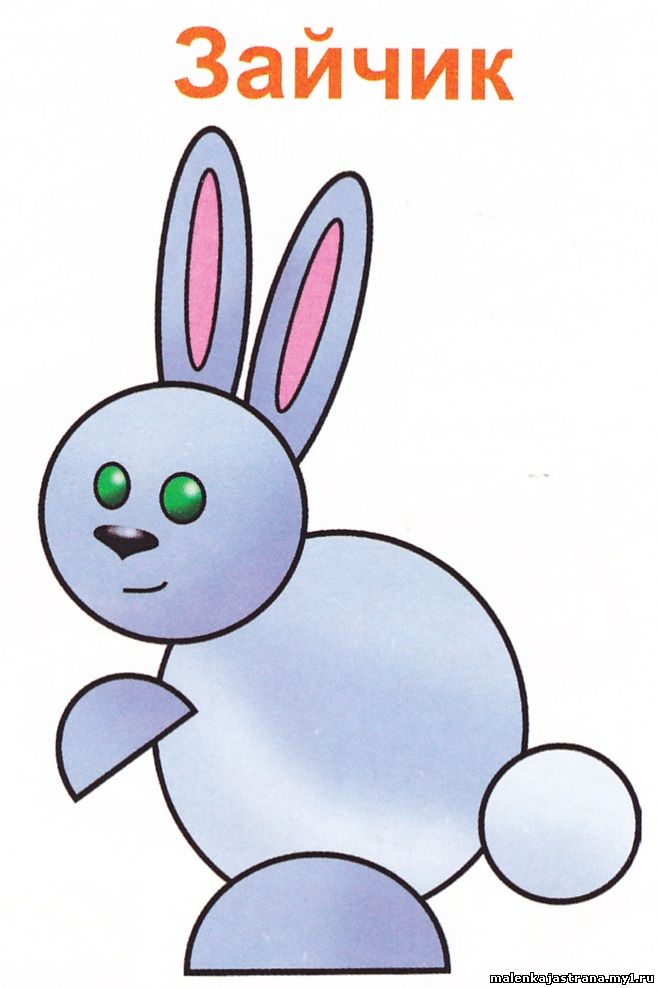
Heart Bunny
The original way to design a gift card for children is a bunny of hearts applique. In the older group and in the preparatory group of the kindergarten, children can already make the elements for the application themselves, cutting them out of colored paper using scissors of the desired size or arbitrarily.  What is needed for the application of a hare from hearts and description of the process:
What is needed for the application of a hare from hearts and description of the process:
- background of a sheet of colored paper of any color;
- two hearts of colored, pink paper, one of white paper (of the same size);
- pink heart slightly smaller, divided in two vertically (for clearance ears hare);
- two small white hearts (for the tail and bunny collar);
- two smaller hearts of black color (hare's eyes) and the same red heart (hare's nose);
- the hare tendrils can be finely cut from small, black rectangles.
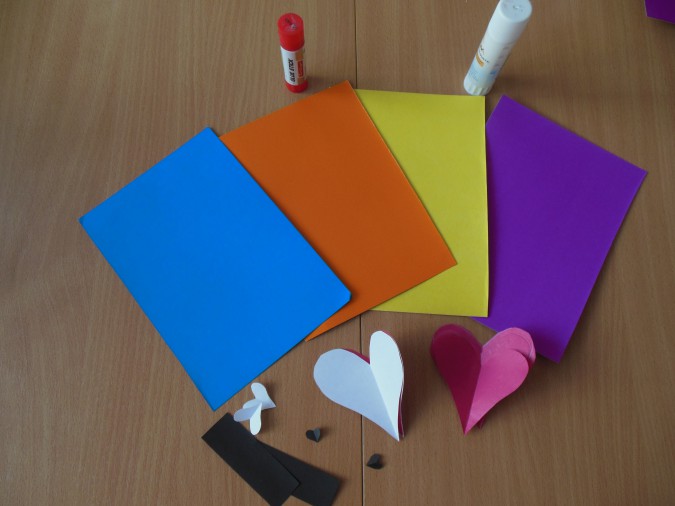 The hare made from hearts looks unusual and is an interesting alternative to standard valentines.
The hare made from hearts looks unusual and is an interesting alternative to standard valentines. 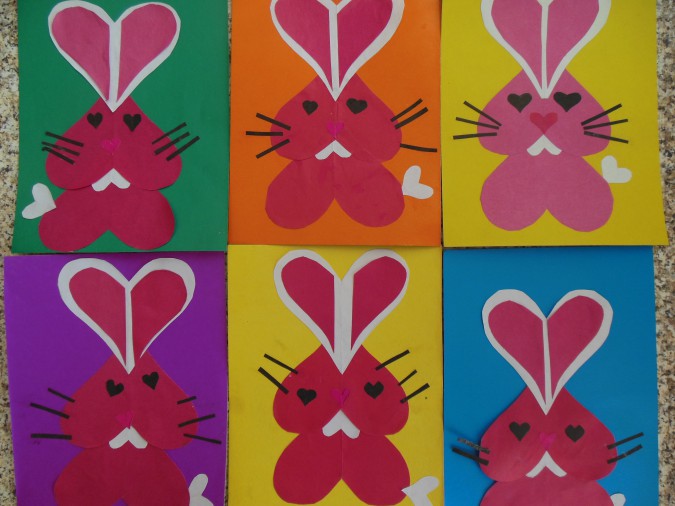
Fabric hare
If, when looking at children's books about bunnies, one of the pictures is especially liked, then you can, with patience and creative enthusiasm, perform the same design hare made from cloth. 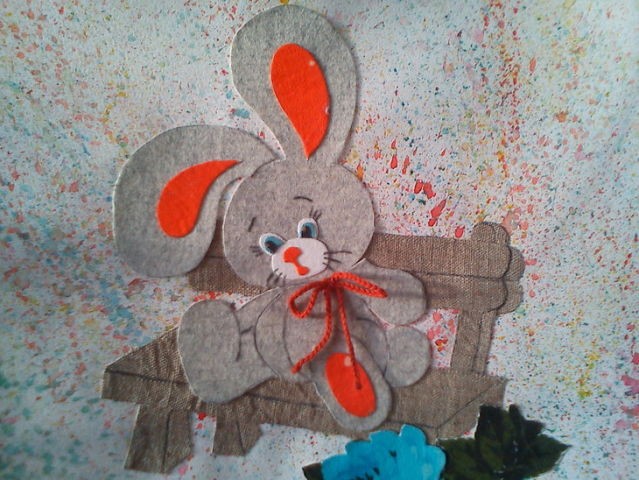 To perform the work will need the following materials:
To perform the work will need the following materials:
- starch;
- fabric of various colors;
- a3 paper sheets, in such quantity, how many layers the application will have;
- glue, preferably PVA;
- hard brush and watercolors;
- markers or markers;
- ribbons to create additional hare or crochet accessories to tie them;
- water tank.
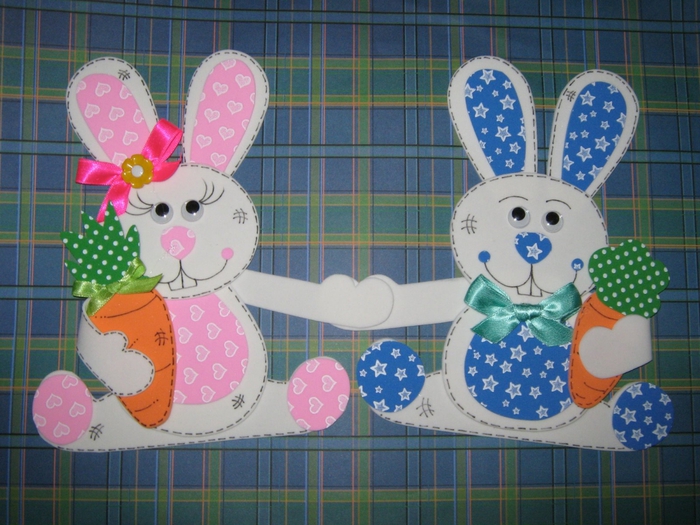 Instructions for the execution of the application hare fabric according to the illustration from the book, step by step:
Instructions for the execution of the application hare fabric according to the illustration from the book, step by step:
- to starch the cloth scraps, you need to dissolve 3 tbsp in a glass of cold water. l starch, then pour the resulting mixture into a liter of boiling water. Then bring the liquid to a boil and leave to cool. In the cooled solution, lower the tissue flaps for a few minutes, squeeze and dry in the hanging position. When the fabric dries, sprinkle it with water and iron it;
- an illustration of a hare you like printed on a sheet of paper A3, otkserokopirovat several times;
- on the back side of the pattern printed on the paper sheets, glue the starch tissue patches with PVA glue, in one layer. Press the sheets for several hours;
- on a blank sheet of A3, sprinkle a brush of watercolors of various colors with a brush, alternately and allow the surfaces to dry;
- the contour of the hare, the largest in area, cut out from a sheet (pasted over with a cloth and dried under a press), then stick as the first layer of application;
- alternately, in accordance with the selected image, cut and paste the remaining details of the application of a hare made of cloth;
- depending on the book design, draw a face to the hare and add accessories from finished tapes or airy loops.
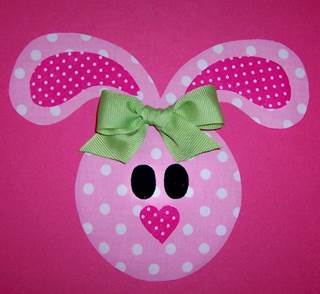 Appliques of a hare made of cloth are interesting in themselves, but it is also an expressive way to decorate ordinary things. Thus, you can make the design of a T-shirt, another item of clothing or, for example, cushions for the interior more interesting and memorable.
Appliques of a hare made of cloth are interesting in themselves, but it is also an expressive way to decorate ordinary things. Thus, you can make the design of a T-shirt, another item of clothing or, for example, cushions for the interior more interesting and memorable.
Bunny from napkins and cotton
A hare from napkins is an interesting and uncomplicated option for classes with preschoolers on the topic of application, in kindergarten or at home.
Materials for the manufacture of bulk applications of napkins:
- color cardboard for the main background;
- solid stencil of white paper hare;
- snow-white napkins;
- cotton wool;
- pVA glue;
- black velvet paper (small rectangle, for thin hare antennae).
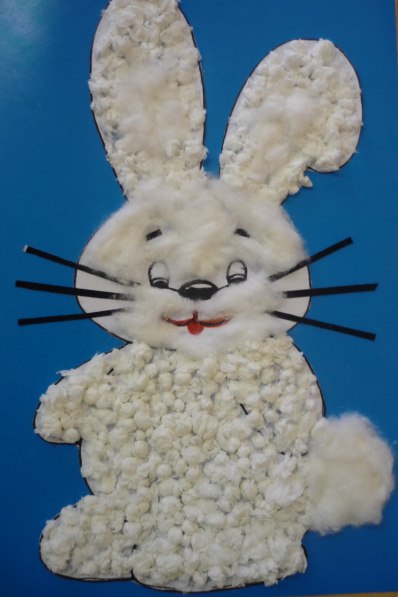
A detailed description of the implementation of the bunny napkins:
- wipes gently break into small pieces and roll each into a small rounded lump;
- the hare's figure is tightly glued with paper buns on the PVA (glue is applied to the entire area of the stencil, and then napkins are applied);
- bunny glued to the background;
- in the area of the ears, muzzle and tail, fluffy cotton is glued;
- the application is completed by sticking a mustache (the muzzle can be drawn on the stencil in advance).
Palm bunny
Hares, hand-made appliqués from the palms look incredibly beautiful. Such crafts remarkably decorate the everyday interior of the children's room or the festive hall of the kindergarten.  For the manufacture of high-quality template palm child, it is necessary that he pressed his hand a sheet of cardboard to the surface of the table. Then the palm is contoured. You can circle the arm to the elbow, but also the version of the pattern to the wrist will be an excellent material for co-creation.
For the manufacture of high-quality template palm child, it is necessary that he pressed his hand a sheet of cardboard to the surface of the table. Then the palm is contoured. You can circle the arm to the elbow, but also the version of the pattern to the wrist will be an excellent material for co-creation. 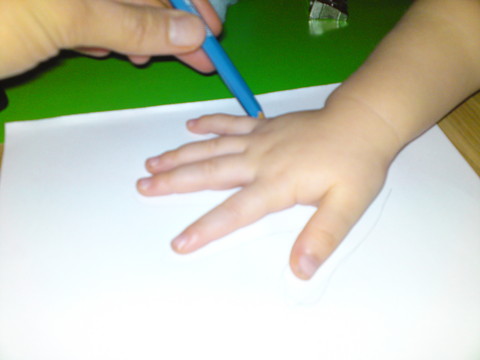 Then, already on the blank cut out of cardboard, the details of the palms of colored paper are made. In the middle group, preschoolers can already trace the patterns of their palms on their own, and in becoming older they can cut out blanks for application under the guidance of a tutor.
Then, already on the blank cut out of cardboard, the details of the palms of colored paper are made. In the middle group, preschoolers can already trace the patterns of their palms on their own, and in becoming older they can cut out blanks for application under the guidance of a tutor. 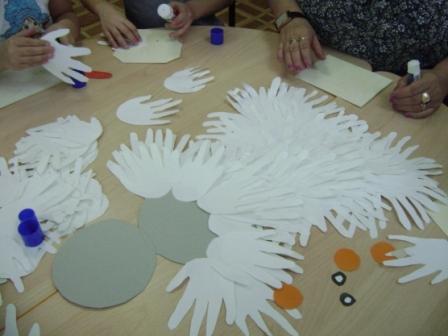 You can complete the application of the hare completely, or just his face. In any case, excellent results are guaranteed. All children, without exception, really enjoy classes on creating hand-made applications.
You can complete the application of the hare completely, or just his face. In any case, excellent results are guaranteed. All children, without exception, really enjoy classes on creating hand-made applications.  Crafts rabbits appliqué of the palms, left as a keepsake, will give occasion in the future for pleasant memories of childhood. You can perform a bunny application not only from colored paper, but also on a fabric basis.
Crafts rabbits appliqué of the palms, left as a keepsake, will give occasion in the future for pleasant memories of childhood. You can perform a bunny application not only from colored paper, but also on a fabric basis. 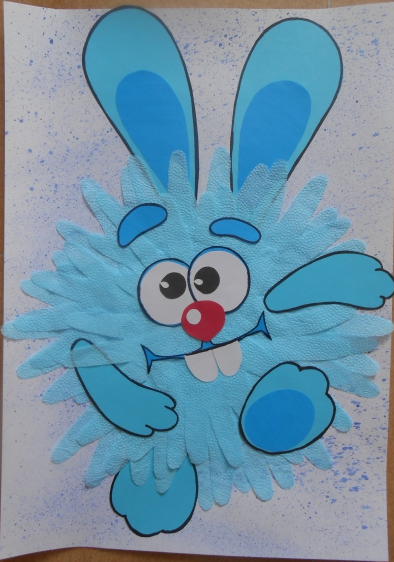
Crumb from disc and colored paper
Everyone's favorite hero of the animated series "Smeshariki."
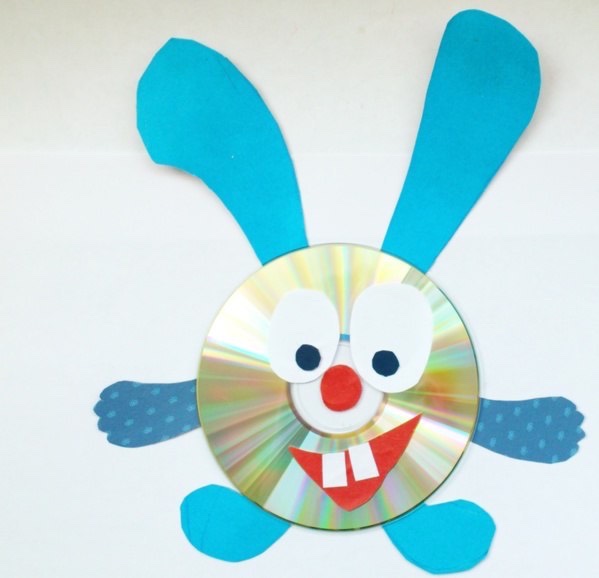 A cheerful face of a hare of appliqué made from an unnecessary music disc will cheer up every day. She can diversify the interior of the kitchen, bathroom or car.
A cheerful face of a hare of appliqué made from an unnecessary music disc will cheer up every day. She can diversify the interior of the kitchen, bathroom or car. 
Video: Making Crochet of Smeshariki
Carrot for bunny
Application Carrot can be made to complement any application with a story about hares, because this is their favorite food, an indispensable accessory and the best dream.
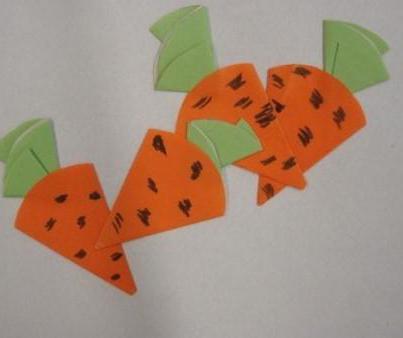 How to perform the application carrot - pocket step by step:
How to perform the application carrot - pocket step by step:
- a circle of orange or red paper is divided in half with scissors and folded three times, then the two contacting extreme sides are glued together;
- on the resulting carrot, it is necessary to clarify the horizontal horizontal strokes inherent in this vegetable. This can be done with black pencil or pasted dark threads;
- the next stage is green foliage. The green paper circle is folded in half, rolled up several times in a zigzag. The corners of the semicircle are slightly shifted to create an interesting shape of the beam;
- carrot - pocket and greens are glued together.
The resulting carrot for a bunny ̶ itself is multifunctional, thanks to a convenient pocket. And any application with hares will look great, especially in sufficient quantities.
Hare in the forest
It is especially pleasant to be engaged in application, especially, together with children when an opportunity is given to use natural materials for occupations. For the application of a hare in the forest, autumn or summer leaves of various shapes will be useful. Such crafts will decorate the weekday, will be a peculiar highlight of the home interior.  When doing a forest bunny, you will need slightly ironed, or dried in the books leaves, glue, scissors, cardboard or paper for the background of the appliqué, a pencil. In addition to the hare itself, the entire forest landscape can be represented as leaves: fir-trees, birds, bushes.
When doing a forest bunny, you will need slightly ironed, or dried in the books leaves, glue, scissors, cardboard or paper for the background of the appliqué, a pencil. In addition to the hare itself, the entire forest landscape can be represented as leaves: fir-trees, birds, bushes.
Bunny under the Christmas tree
The original technique of performing this application ̶ corrugating colored paper may seem complicated for beginners. But this is not the case, especially if you thoroughly approach the process of creating the bunny itself under the Christmas tree. The finished application is so airy that it looks wonderful not only against a background of colored paper or cardboard, but even on a grid of intertwined and glued together threads fixed in a thin frame.  For the Christmas tree will require a certain number of green leaves - twigs. Each such element is made of a triangle of colored green paper, folded into a thin corrugated harmonica, folded in half and glued into a sheet-like form. Made in the right amount of elements fixed with glue on the background and are interconnected in the form of a Christmas tree.
For the Christmas tree will require a certain number of green leaves - twigs. Each such element is made of a triangle of colored green paper, folded into a thin corrugated harmonica, folded in half and glued into a sheet-like form. Made in the right amount of elements fixed with glue on the background and are interconnected in the form of a Christmas tree.  For the head of a corrugated bunny, two snow-white rectangles will be needed, which after assembly into a small fold form two semicircles. Then the parts are glued together in a circle. The eyes and nose of the bunny are decorated with a marker or beads, if desired. The hare's body is made of a larger rectangle, gathered in a fold and glued together in a semicircle.
For the head of a corrugated bunny, two snow-white rectangles will be needed, which after assembly into a small fold form two semicircles. Then the parts are glued together in a circle. The eyes and nose of the bunny are decorated with a marker or beads, if desired. The hare's body is made of a larger rectangle, gathered in a fold and glued together in a semicircle.  Hare ears and legs can be made from white triangles of the desired size, assemble and glue like Christmas tree twigs. Fluffy round tail is made of rectangles, assembled in semicircles, glued together.
Hare ears and legs can be made from white triangles of the desired size, assemble and glue like Christmas tree twigs. Fluffy round tail is made of rectangles, assembled in semicircles, glued together.
"Bunny - runaway" cut and sticking
Gradually following the pattern creation and application process, even a beginner can create a real forest glade full of hares. To do this, you need to perform every detail in the number of hare conceived. You can diversify the landscape with an evergreen tree or just flowers. 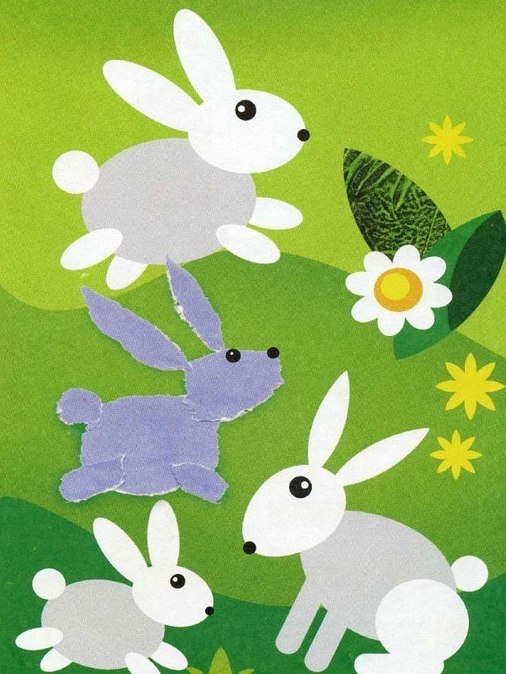 For the body of each rabbit you will need to cut a larger circle from a rectangle folded in half. A circle for the head is made from a smaller rectangle. Two elongated ovals will be needed for the ears. The circle is cut for the tail and four oval shapes for the legs.
For the body of each rabbit you will need to cut a larger circle from a rectangle folded in half. A circle for the head is made from a smaller rectangle. Two elongated ovals will be needed for the ears. The circle is cut for the tail and four oval shapes for the legs. 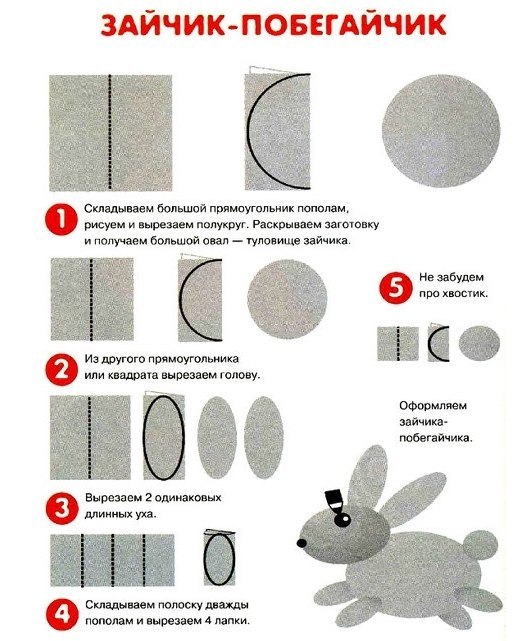
Video: Application of a felt bunny
Goals:
To acquaint with the peculiarities of the hare's appearance and lifestyle.
Enrich active and passive vocabulary on topic.
To form sustainable ideas about color (red, blue, yellow, green), number (one-many), geometric shapes (circle, oval, triangle), size (large-small).
Learn to distinguish between "loud" and "quiet."
Improve the skills of modeling, sticking, drawing with pencils, paint brushes, fingers on the croup.
Learn to find a subject that is different from the rest.
Develop thinking, fine motor skills, coordination of movements.
Equipment:
Toy "hare".
picture background with the image of a hare of geometric shapes, cut out of cardboard, these geometric shapes.
Picture-background with the image of three hemp of different size and colored silhouette pictures of three birds of different size.
Hemp, drums. Cap "Fox".
The picture is a blank with the image of a hare and three lanes, on the end of which is painted food for the hare (carrots, cabbage, mushroom), colored pencils.
Picture-preparation with the image of the garden with glued one large and five small circles, glue, colored silhouette pictures of big and small cabbage.
Plasticine orange sprig of cypress.
Picture-background with the image of a hare and a fox in the forest, cut out of green cardboard silhouettes of Christmas trees of three sizes.
The picture is a blank with the image of hares and a wolf, brushes, non-molded with water, green gouache.
Multicolored clothespins, hare silhouettes, cut from thick cardboard in shirts of different colors.
Lamp or flashlight.
The picture with the image of three identical birds with one stone and one different from the others.
Trays with semolina.
Audio Recording: N. Rimsky-Korsakov "Zainka".
Lesson progress:
Greeting "Everyone clapped their hands"
Everyone clapped their hands,
Friendly, more fun!
Our feet were knocked,
Louder and faster!
On the knees hit.
Hush, hush, hush.
Handles, handles raise,
Higher, higher, higher!
Turned our pens.
Down again.
Circled, circled
And stopped.
Surprise moment "Who hid behind a curtain?"
Today a guest ran to us from the forest, but he is afraid to go out, hiding behind a curtain. Let's open the curtain and see who is so fearful there. Yes, it's a hare! let's calm him down, say to him: “Do not be afraid, bunny!” After all, we will not offend the bunny. On the contrary, we will play with him, draw, draw, and do many more interesting things.
Construction "Bunny"
You have a lot of different geometric shapes. If you lay each of them in its place, you get a bunny.
This figure is called a circle. We have two laps. Show a big circle, a small circle. Where to put a big circle? (Head). And the little circle? (Tail). But this figure is called an oval. Ovals are many - three. Show one big oval, two small ovals. where do we put a big oval? (Torso). And where do we put two small ovals? (Ears). one piece left - a triangle. where to put it? (Paws).
Didactic game "Rassadi hares on stumps"
Here are hemp. Show the largest stump, the smaller stump, the smallest. And here the hares came running, help them to sit on the stumps - pick up each hare for a stump that suits it: put the biggest hare on the stump the biggest, a smaller hare sit on the smaller stump, well, sit on the smallest hare on the smallest stump.
Dynamic pause with drums “Bunny sat on a stump”
And now the boys turn into hares, jump to the stumps and sit on them.
Skok-poskok, skok-pokok,
Bunny jumps - and on the stump.
Now take the drums and listen to what you need to do:
In the drum, he beats loudly,
All friends play is calling.
And now quieter beats,
He calls friends to sleep.
Drawing with pencils “Spend the hare to food”
Here is the picture bunny. He is hungry and wants to eat. You need to spend a bunny to the food. Which path do you need to go to Zaika to come to the carrot? what color is this track? Red. Pick up a red pencil and guide the Bunny along this path so that he can eat the carrot. (Further, the same with cabbage and mushroom with blue and green pencils).
Application "Cabbage for hares"
In the garden grew cabbage. Glue the cabbage on the circles in the garden: glue the big cabbage on the big circle, glue the small cabbage on the small circle. how much has grown big cabbage? One and how much has grown a small cabbage? Lot.
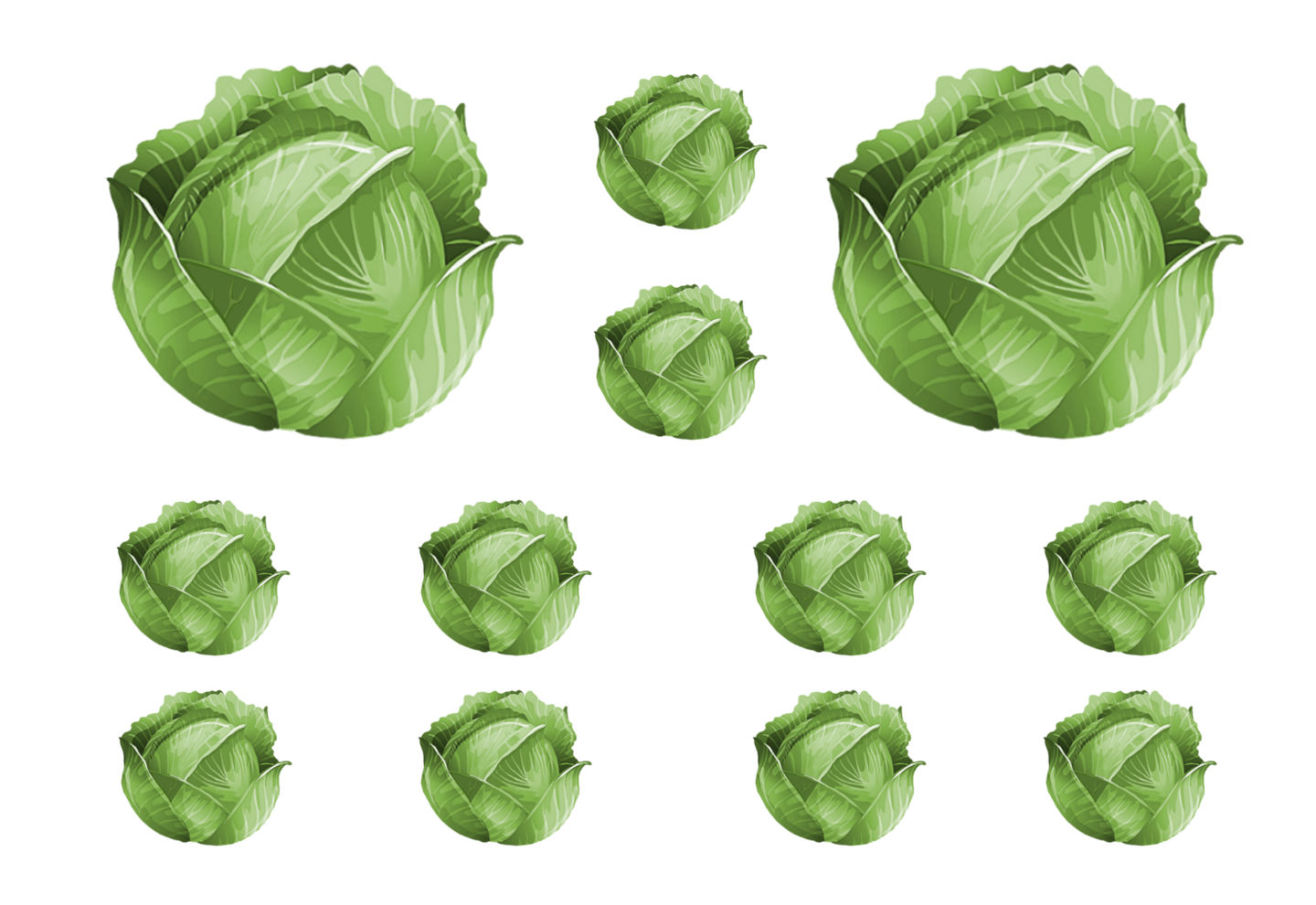
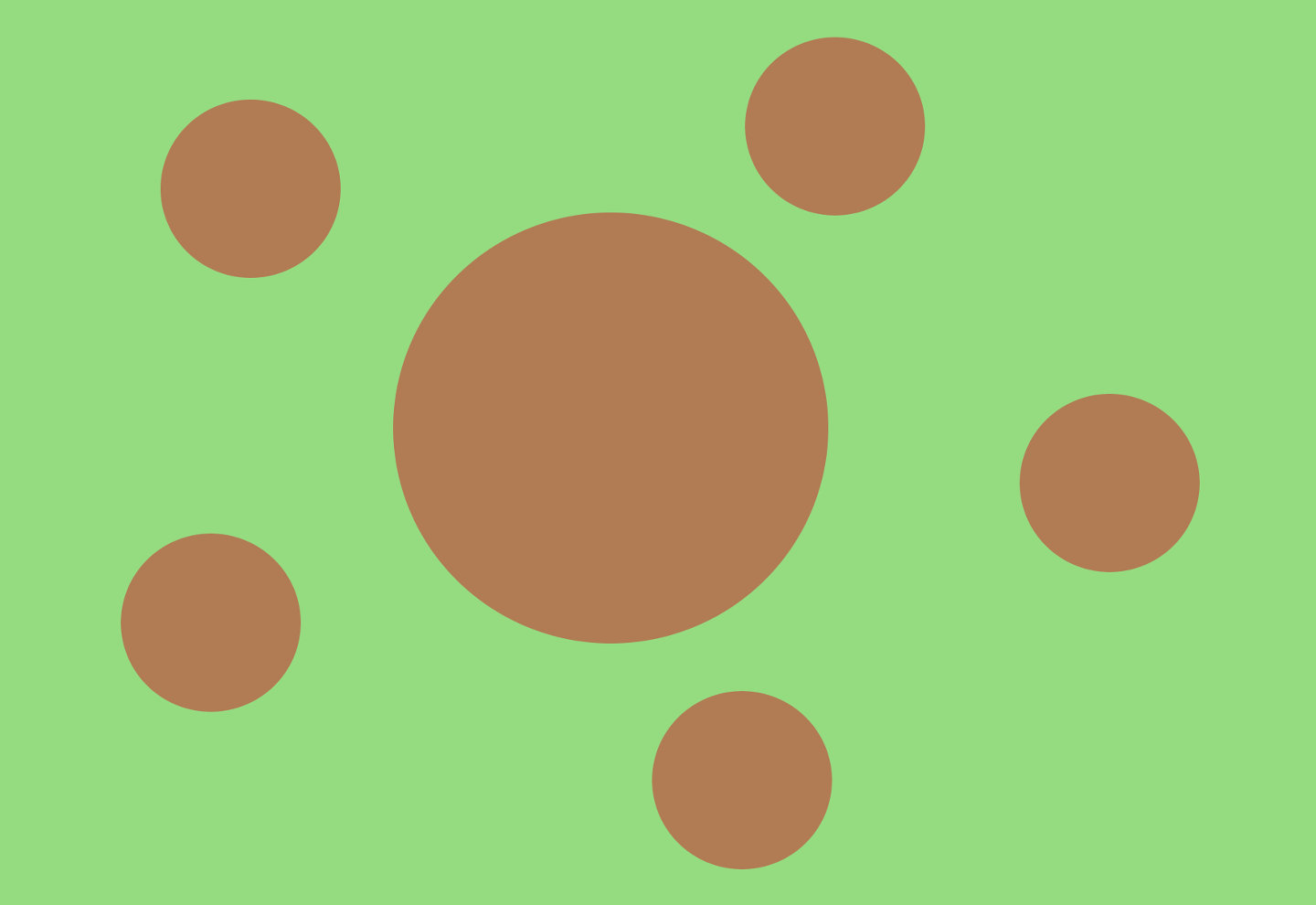
Sculpture "carrot"
What do hares like to eat? Grass, cabbage, carrot. Let's blind carrot hares. Roll a thick sausage from a piece of plasticine with a straight roll and then roll one end of the sausage with your finger - you’ll have the sharp end of a carrot. In another carrot horses stick a green twig. Carrot turned out like a real one!
Finger gymnastics "Cabbage Salting"
We chop cabbage.
(Hands show how we chop the cabbage)
We carrot three-three.
(Handles show how we three carrots)
We salt the cabbage, salt.
(Fingers pinch-salt)
We mnem cabbage we.
(Pens "mnem" cabbage)
Mobile game "Bunnies and Chanterelle"
Bunnies ran across the forest lawn.
They sat a little darling in a circle, dig a back with a foot.
Here are some bunnies, bunnies - runaway.
Suddenly a chanterelle, a red sister, runs
Looking for where are the hare, hare - the vagaries.
(At the end of the song "hares" run away from the teacher, who wore a fox hat)
Didactic game "Hide the hare from the fox"
I walked bunny, but suddenly I saw a fox. What to do, you need to hide soon. Here, near the Christmas trees are growing. Just what kind of Christmas tree to hide. so that the fox did not notice? Help the hare to choose a Christmas tree beyond which it will not be visible. (In the course of the assignment, the tutor asks the children why they did not take the small or medium Christmas tree, but chose the largest one?)
Drawing colors "Hide the hare from the wolf"
A lot of enemies have a hare in the forest: an owl from the sky strives to attack, on earth the fox and the wolf chase the hare. So these hares are hiding from the wolf. let's help the hares - let's draw thick grass so that the hares cannot be seen behind it, then the wolf will not notice them. Take the brushes, dip them first in the water, then shake off the water droplets and dip them in the green paint. Paint brush draw a line of grass from top to bottom.

Didactic game "Distribute pencils to hares"
This Bunny is an artist, he loves to draw. Before him stands an easel - a special table for drawing. Put on a easel a zaykin drawing, and now look closely at the drawing - what color it is painted.
Find a wand of the same color and put it in your bunny's hand - this will be the pencil with which the bunny painted this picture.
(Then the children change the pictures and, accordingly, sticks-pencils).
Dynamic pause "Bunny"
Children perform movements to music in the treatment of N. Rimsky-Korsakov "Little Hare" modeled on the teacher, according to the text:
Bunny, turn around,
Gray, turn around,
So, turn around.
Bunny, stomp foot,
Gray, stomp leg,
That's it, commercials stump leg.
Bunny, swim,
Gray, dance it,
So, that way, some kind of dance.
Playing with clothespins "Bunny"
Make hares handles and legs out of clothespins. But be careful, take the clothespins of the same color as your rabbit's shirt.
Exercise "Theater of Shadows"
Children are invited to fold their hand in the cam, putting the index and middle fingers - "bunny ears." Place the “hare” folded out of your fingers between the wall and the light source to get a clear shadow. You can offer children to move the "hare" - jump, move and pull ears, catch the other hand.
Jumping, jumping bunny,
You catch him!
Look carefully at these hares and show one that is not like the others. How is it different from others? All hares are big and he is small.
And in this picture, what kind of hare is different from the others? All hares are gray, and one is white.

Drawing fingers "Footprints"
On trays with semolina, children leave two fingerprints at the same time, moving across the entire plane of the tray.